What, exactly, is rumba clave?
I don't mean that in a Latin Music 101 kind of way, but in the real world, how do rumberos play clave? And is there a "correct" rumba clave? How much room is there for personal (or regional) style? How does tempo affect the placement of the five notes? Has it changed over time?
One thing is certain: What you see in standard western notation as written-clave is a long way from what's actually played.
But what is actually played? And can that somehow be illustrated? Well, I took a shot at it (with recordings containing rumba clave, a music editor, and Photoshop), and you'll find the results below.
To better illustrate the difference between what's written and what's actually played, the first two tracks are examples of straight clave (aka "written-clave"), both in 4/4 and 12/8. The 12/8 clave presented here is really just a stripped-down version of the standard 12/8 bell pattern, with the first note of each of the two double-hits removed.
Illustration notes:
For a given clave recording we want to be able to see where the notes fall in relation to both 4/4 and 12/8 written-clave. To that end, each illustration has the following components:
- 4/4 marks at the top in blue:
A given amount of time, in this case one measure of clave, can be broken into 16 graphical units of equal width/time, representing 16th notes. - 4/4 written-style rumba clave marks (green arrows at top)
- 12/8 marks at the bottom in red:
The same amount of time can also be broken into 12 graphical units of equal width/time. - 12/8 written-style rumba clave marks (green arrows at bottom)
- Basic 4-beat pulse per one measure of clave at bottom (same position in time for both 4/4 and 12/8 claves).
- Waveform of clave:
Viewed in a music editor. One measure, usually the first from a given track, as it's the cleanest.
The tracks chosen all have at least one complete measure of only rumba clave, without other instruments (especially palitos) unduly cluttering up the waveform and impacting the accuracy of the graphing. I tried to come up with a set that contains tracks of (1) various tempos, (2) the same tempo by different players/groups, and (3) different eras. Little consideration was given to whether I actually liked a track/song (though there are some good ones here); the fact is that there just aren't that many tracks out there suited to this purpose.
(Note: I did not research the individual actually playing claves on each track - the group/singer/leader listed next to "Artist" will have to suffice.)
30-second audio clips of each track are included as well, along with notations for beats per minute (bpm). Conclusions are at the bottom of page.
[Note on audio clips: Some people with IE are having issues - if they don't work, try Firefox or Safari.]
Written/Straight Clave in 4/4, 112 bpm
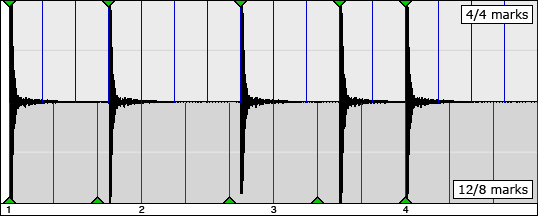
Written/Straight Clave in 12/8, 112 bpm
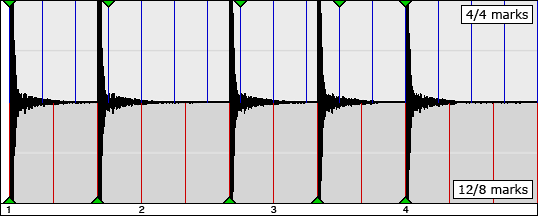
Speed: 98 bpm
Artist: Isaac Delgado | Album: Rumba Pa'l Pueblo | Track: Santa Cecelia
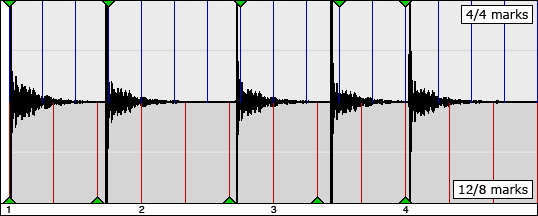
Speed: 100 bpm
Artist: Rumberos de Cuba | Album: ¿Dónde Andabas Tú, Acereko? | Track: El Trovador
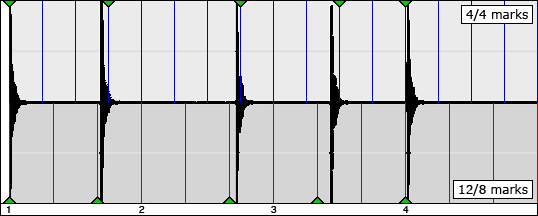
Speed: 102 bpm
Artist: Rumboleros | Album: Protesta Carabali | Track: Linda Habana Yambu
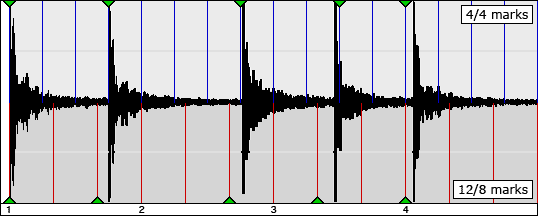
Speed: 116 bpm
Artist: Carlos Embale | Album: Rumbero Mayor II | Track: Chambeleque
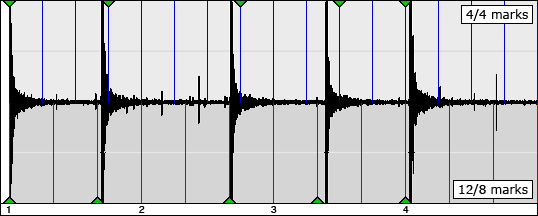
Speed: 122 bpm
Artist: Afrekete | Album: Iyabakua | Track: Timbata
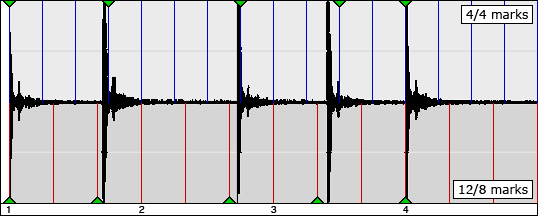
Speed: 122 bpm
Artist: Los Parragueños | Album: Rumba Rarities | Track: Virgencita de Mi Camino
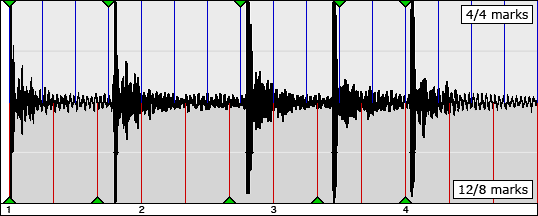
Speed: 138 bpm
Artist: Los Munequitos de Matanzas | Album: Rumba Caliente 88/77 | Track: Mi Arere
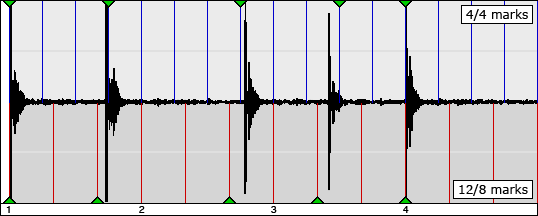
Speed: 144 bpm
Artist: Pancho Quinto | Album: En El Solar La Cueva Del Humo | Track: La Media
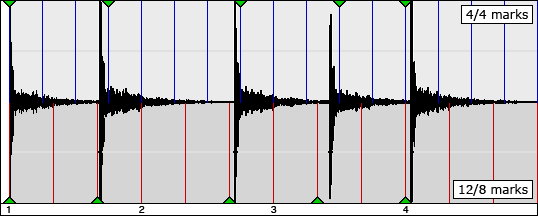
Speed: 156 bpm
Artist: Clave y Guaguanco | Album: Dejala en La Puntica | Track: Capricho de Abuela
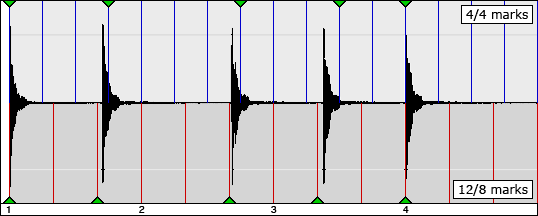
Speed: 168 bpm
Artist: Ecue Tumba | Album: En Un Solar De Pogoloti | Track: Guaguanco Matancero
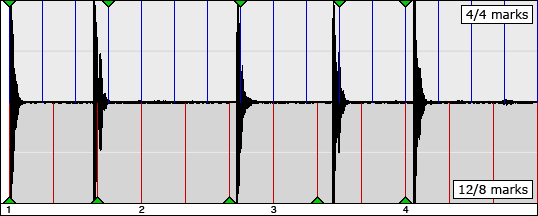
Conclusions:
The biggest thing that stands out, both graphically and in the audio, is just how different the written clave is to what's in the recordings. No surprise there, really, but it's amazingly clear when laid our like this.
Also, I came into this with the idea that at slower Yambu-like tempos, the feel would be closer to straight 4/4 time, and then as the tempo increased the clave would be played closer and closer to straight 12/8. I can no longer say that is strictly the case, as evidenced by the strong similarity between the clave in the Carlos Embale track at 116 bpm and that of the Clave y Guaguanco track at 156 bpm, both of which have a strong 12/8 feel.
Overall, though, what really strikes me is just how much variability there is, and that speaks to this conclusion:
That being said, however, the data illustrated does lead to certain observations and a recognition of standard/best practices. Let's take it note by note:
1st note:
A given; it's always on the ONE (at steady tempos).
2nd note:
In all cases but one (the Los Parragueños track at 122 bpm), it's either right on the 4/4 mark or pulled forward in time, in some cases all the way to the 12/8 mark. Although the tracks with the strongest 12/8 feel here are really fast, there are slower tracks here that also have the 2nd note placement closer to 12/8.
3rd note:
Almost the same scenario as for the 2nd note, with a lot of variability. For a given track, the placement of the 3rd note mirrors the 2nd in relation to the marks (i.e., if the 2nd note is pushed/delayed, the 3rd note will be pushed just about the same amount). The only real exception is the Ecue Tumba track at 168 bpm.
4th note:
OK, this one is key. Regardless of what happens with the 2nd, 3rd, and 5th notes, this one has amazingly highly consistent placement across all tracks and speeds. It's NEVER played on the 4/4 mark or after - ALWAYS before. Always pulled forward in time. Never quite as far as the 12/8 mark, but right in there between 4/4 and 12/8 (along the lines of Mike Spiro's idea of "FIX" - between Four and Six).
5th note:
Consistently right on the 4/4 mark or a bit after - never before.
Other observations:
Although the last 3 notes are never quite equidistant (as they would be played in straight 12/8), their relative spacing is far from straight 4/4 written-clave (with that big pause between the 3rd and 4th notes, and the last two notes clustered together at the end).
I think the nine tracks presented here reflect a fair sampling of how rumba clave is really played, though one must bear in mind that for each track only one measure of clave has been pulled out and illustrated. There is no doubt some variability throughout any given track. Also, I did sample from the beginnings of the songs, before the other instruments came in, and it's possible that in some cases the clave might shift in relation to whatever else is going on, and/or settle in as the groove gets established, but I would think this to be less of an issue with established groups playing together regularly.
Answering all the questions brought up in the intro is not yet possible; any input you might have would be greatly appreciated. Hopefully we'll fill in the blanks.
Back to the woodshed,
James
( jemuzu [at] gmail [dot] com )
(Special thanks to Mike Spiro and David Penalosa for their inspiration for this project.)
Note: For consistency and simplicity, I intentionally left Columbia and other rhythms containing rumba clave out of this for now.